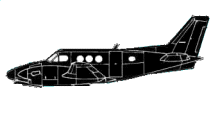
ASN Wikibase Occurrence # 297984
This information is added by users of ASN. Neither ASN nor the Flight Safety Foundation are responsible for the completeness or correctness of this information.
If you feel this information is incomplete or incorrect, you can submit corrected information.
| Date: | Thursday 12 July 2018 |
| Time: | 02:05 LT |
| Type: |  Beechcraft 90 King Air |
| Owner/operator: | Guardian Flight LLC. |
| Registration: | N617MM |
| MSN: | LJ-1587 |
| Year of manufacture: | 2000 |
| Engine model: | Pratt & Whitney PT6 |
| Fatalities: | Fatalities: 0 / Occupants: 3 |
| Aircraft damage: | Substantial |
| Category: | Accident |
| Location: | Tolani Lake, Arizona -
 United States of America United States of America
|
| Phase: | En route |
| Nature: | Ferry/positioning |
| Departure airport: | Flagstaff-Pulliam Airport, AZ (FLG/KFLG) |
| Gallup-Senator Clark Airport, NM (GUP/KGUP) | |
| Investigating agency: | NTSB |
| Confidence Rating: |
The pilot reported that the airplane was climbing in instrument meteorological conditions with light rain and with the autopilot engaged. The conditions were smooth with no turbulence and no known icing, although he had engaged all anti-icing systems. The airplane was climbing at 600 ft per minute at an airspeed of 130 kts from 17,000 ft to 19,000 ft. The pilot reported that he was working on an iPad when it stopped functioning. He said he was resetting the iPad when there was a hard control input to the left as the airplane was passing through about 17,500 ft. The airplane rolled left and pitched down as he attempted to regain control. The pilot reported the autopilot was fighting his control inputs during the event, and he disengaged it to affect the recovery. Onboard data equipment showed a steady increase in airplane pitch attitude and a steady decrease in airspeed before the upset. The airplane spiraled down, losing about 4,000 ft of altitude before the pilot regained control. The pilot manually flew the airplane to its destination and landed safely. The wings were substantially damaged.
Postaccident examination of the autopilot revealed no mechanical anomalies that would have precluded normal operation. The autopilot computer was removed and examined with no anomalies noted. Thus, the reason for the autopilot deviation could not be determined. It is likely that the pilot was distracted with resetting the iPad and thus did not adequately monitor the autopilot, which led to his delayed awareness of the autopilot deviation.
Probable Cause: An autopilot deviation during climb for undetermined reasons, which resulted in an in-flight upset and loss of airplane control. Contributing to the accident was the pilot's failure to adequately monitor flight systems due to a distraction.
Accident investigation:
 |
|
Sources:
NTSB WPR18LA197
Location
Revision history:
| Date/time | Contributor | Updates |
|---|---|---|
| 15-Oct-2022 11:24 | ASN Update Bot | Added |
Corrections or additions? ... Edit this accident description
The Aviation Safety Network is an exclusive service provided by:


 ©2024 Flight Safety Foundation
©2024 Flight Safety Foundation